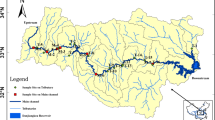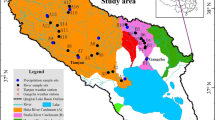Abstract
For researching the spatio-temporal variation of the stable isotopic composition of the riverine dissolved inorganic carbon (DIC), we had carried out a survey throughout the hydrologic year during which the δ13CDIC of the surface water and its physicochemical parameter were examined along the Xijiang River Inner Estuarine waterway from September 2006 to June 2007. There was a striking seasonal variation on the average δ13CDIC, as the average δ13CDIC in summer (−13.91‰) or autumn (−13.09‰) was much less than those in spring (−11.71‰) or winter (−12.26‰). The riverine δ13CDIC was controlled by decomposed condition of the riverine organic matter linking the seasonal variation of the physicochemical parameter in the surface water according to the correlation analysis which indicated notable relations between δ13CDIC and water temperature (p = 0.000; r = −0.569) or between δ13CDIC and oxide-reduction potential (p = 0.000; r = 0.646). The striking positive correlation between δ13CDIC and the sampling distance happened in the summer rainy season, while striking negative correlation happened in the spring dry season, indicating that river-sea interaction influenced water physicochemical parameters and controlled the riverine DIC property in the survey waterway. In view of the riverine δ13CDIC decreasing for the decomposition of the terrestrial organic matter in the rainy season in summer and increasing for the briny invaded zone extending in the spring dry season along the waterway from the Makou gauging station to the Modaomen outlet, the δ13CDIC spatio-temporal variation was closely related to the geographical environment of the Xijiang drainage basin.
Similar content being viewed by others
References
Amiotte-Suchet P, Aubert D, Probst J L et al., 1999. δ13C pattern of dissolved inorganic carbon in a small granitic catchment: The Strengbach case study (Vosges Mountains, France). Chemical Geology, 159: 129–145.
Chen Jingsheng, He Dawei, 1999. Chemical characteristics and genesis of major ions in the Pearl River basin. Acta Scientiarum Naturalium Universitatis Pekinensis, 35(6): 786–792. (in Chinese)
Dai Minghan, Guo Xianghui, Zhai Weidong et al., 2006. Oxygen depeletion in the upper reach of the Pearl River Estuary during a winter drought. Marine Chemistry, 102: 159–169.
Degens E T, Kempe S, Richey J E, 1991. SCOPE 42: Biogeochemistry of major world rivers. UK: Wiley.
Deng Wenfeng, Wei Gangjian, Li Xianhua, 2005. Online analysis of carbon and oxygen isotopic composition of impure carbonate. Geochemica, 34(5): 495–500. (in Chinese)
Editorial Committee of Chorography of the Pearl River, 1991. Chorography of the Pearl River (Vol. 1). Guangzhou: Guangdong Technology Publishing House, 1–150. (in Chinese)
Gao Quanzhou, Shen Chengde, 1998. Riverine carbon flux and continental erosion. Advance in Earth Sciences, 13(4): 369–375. (in Chinese)
Gao Quanzhou, Shen Chengde, Sun Yanmin et al., 2001. The chemical weathering in Zhujiang River drainage. Geochemica, 30(2): 223–229. (in Chinese)
Gao Quanzhou, Tao Zhen, Shen Chengde et al., 2002. Riverine organic carbon in the Xijiang River (South China): Seasonal variation in content and flux budget. Environmental Geology, 41(7): 826–832.
Han Wuying, Lin Hongying, 1992. Carbon flux and carbon cycle in the Pearl River Estuary. Acta Oceanologica Sinica, 14(1): 56–63. (in Chinese)
IGBP, IHDP, WCRP, 2001. The carbon challenge: An IGBP-IHDP-WCRP Joint Project. Stockholm: International Geosphere and Biosphere Programme, 3–12.
Li Yan, Zhang Longjun, Su Zheng et al., 2006. Rapid variation of pCO2 and its influencing factors at the initial mixing stage of freshwater and saltwater in the Changjiang River Estuary. Periodical of Ocean University of China, 36(2): 295–298. (in Chinese)
Ludwig W, Probst J L, Kempe S, 1996. Predicting the oceanic input of organic carbon by continental erosion. Global Biogeochemistry Cycle, 10(1): 23–41.
Luo Xielin, Yang Qingshu, Jia Liangwen et al., 2002. River-bed Evolution of the Pearl River Delta. Guangzhou: Sun Yat-sen University Press, 9–37. (in Chinese)
Meybeck M, 1982. Carbon, nitrogen and phosphorus transport by world rivers. Am. J. Sci., 282(4): 401–450.
Meybeck M, 1993. Riverine transport of atmospheric carbon: Sources, global typology and budget. Water, Air, & Soil Pollution, 70: 443–463.
Ou Suying, Yang Qingshu, 2004. Interaction of fluctuating river flow with a barotropic tide in river network of the Zhujiang Delta. Acta Oceanologica Sinca, 26(1): 125–131. (in Chinese)
Su Zheng, Zhang Longjun, Wang Xiaoliang, 2005. Influencing factors of partial pressure of CO2 in Huanghe (Yellow) River. Marine Sciences, 29(4): 41–44. (in Chinese)
Telmer K, Veizer J, 1999. Carbon fluxes, pCO2 and substrate weathering in a large northern river basin, Canada: Carbon isotope perspectives. Chemical Geology, 159: 61–86.
Wachniew P, 2006. Isotopic composition of dissolved inorganic carbon in a large polluted river: The Vistula, Poland. Chemical Geology, 233: 293–308.
Yao Guangrong, 2007. Seasonal and spatial variations of dissolved inorganic carbon and tracing of its δ13C sources in the lower reaches of Xijiang River, China. Guangzhou: Sun Yat-sen University. (in Chinese)
Yao Guangrong, Gao Quanzhou, Wang Zhengang et al., 2007. Dynamics of CO2 partial pressure and CO2 out-gassing in the lower reaches of the Xijiang River, a subtropical monsoon river in China. Science of the Total Environment, 376: 255–266.
Yuan Daoxian, Zhu Dehao, Weng Jintao et al., 2004. Karst of China. Beijing: Geological Publishing House, 1–207. (in Chinese)
Zhai Weidong, Dai Minghan, Cai Weijun et al., 2005. High partial pressure of CO2 and its maintaining mechanism in a subtropical estuary: The Pearl River Estuary, China. Marine Chemistry, 93: 21–32.
Zhai Weidong, Dai Minghan, Guo Xianghui, 2007. Carbonate system and CO2 degassing fluxes in the inner estuary of Changjiang (Yangtze) River, China. Marine Chemistry, 103: 342–356.
Author information
Authors and Affiliations
Corresponding author
Additional information
Foundation: National Natural Science Foundation of China, No.40671027; No.40471120; Guangdong Provincial Natural Science Foundation, No.7003669; Specialized Research Fund for the Doctoral Program of Higher Education, No.20040558025; The Program for New Century Excellent Talents in University
Author: Jiao Shulin (1969–), Ph.D Candidate, specialized in land surface processes of drainage basin and its environmental evolution.
Rights and permissions
About this article
Cite this article
Jiao, S., Tao, Z., Gao, Q. et al. Stable isotopic composition of riverine dissolved inorganic carbon of the Xijiang River Inner Estuary. J. Geogr. Sci. 18, 363–372 (2008). https://doi.org/10.1007/s11442-008-0363-3
Received:
Accepted:
Published:
Issue Date:
DOI: https://doi.org/10.1007/s11442-008-0363-3




